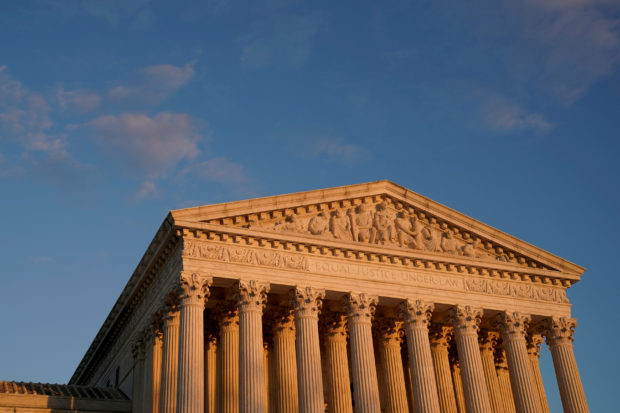US Supreme Court mulls Trump bid to exclude illegal immigrants from population count

FILE PHOTO: A general view of the U.S. Supreme Court building at sunset in Washington, U.S. November 10, 2020. REUTERS/Erin Scott/File Photo
WASHINGTON — U.S. Supreme Court justices on Monday are set to consider President Donald Trump’s move to exclude illegal immigrants from the population totals used to allocate congressional districts to states, a facet of his hardline stance toward immigration being pursued in his final weeks in office.
The court, which has a 6-3 conservative majority including three justices appointed by Trump, is scheduled to hear an 80-minute oral argument by teleconference. The justices are deciding the case on a expedited schedule, with a ruling due before the end of the year. That would make it difficult for Democratic President-elect Joe Biden, set to take office on Jan. 20, to revisit Trump’s plan if it is upheld.
The challengers to Trump’s July directive include various states led by New York, cities, counties and immigrant rights groups. They have argued that the Republican president’s move could leave several million people uncounted and cause California, Texas and New Jersey to lose seats in the U.S. House of Representatives.
House districts are based on a state’s population count in the decennial national census.
The challengers have said Trump’s plan would dilute the political clout of states with larger numbers of illegal immigrants, including heavily Democratic California, by undercounting their true populations and depriving them of House seats. If California loses House districts, that likely would mean Democrats lose House seats, benefiting Republicans.
Article continues after this advertisementThere are an estimated 11 million immigrants living in the United States illegally. Until now, the government’s practice was to count all people regardless of their citizenship or immigration status. The U.S. Constitution requires the apportionment of House seats to be based upon the “whole number of persons in each state.”
Article continues after this advertisementThe challengers have argued that Trump’s policy violates both the Constitution and the Census Act, a federal law that outlines how the census is conducted. Trump’s lawyers said in court papers that he acted within his authority and that the challengers lacked the necessary legal standing to bring the case.
A three-judge panel in New York ruled against the administration in September. Federal courts in California and Maryland have reached the same conclusion in other cases though one court in Washington ruled for Trump.
By statute, the president is due to send Congress a report in early January with the population of each of the states and their entitled number of House districts.
Once states are allocated their districts, they themselves draw the boundaries for the districts, which will be used first in the 2022 congressional elections. The number of House seats for each state also determines how many votes that state gets in the Electoral College, the system used to determine the winner of presidential elections. In a close election, one or two electoral votes could swing the outcome.
Census data also guides the allocation of billions of dollars a year in federal funding to states.
The census itself does not gather data on a person’s citizenship or immigration status. Trump’s administration would base its numbers on data gathered elsewhere, though it has not explained the methods being used. The U.S. Census Bureau, a spokesman said, “will make public the methods used to provide state-level counts once we have them finalized.”
The Supreme Court last year ruled 5-4 against Trump’s effort to add a citizenship question to the census. Critics said the question was intended to frighten immigrants from taking part in the population count and artificially reduce population numbers in heavily Democratic areas, also to benefit Republicans.
Conservative Chief Justice John Roberts joined the liberal justices in that ruling. But the addition of Trump’s third appointee Amy Coney Barrett to the court changes its dynamics, as seen in action by the justices on Wednesday in a case in which they backed Christian and Jewish houses of worship that challenged New York state’s latest restrictions in novel coronavirus hot spots.
Roberts dissented along with the court’s three liberals but Barrett’s vote in favor of the religious groups proved decisive.